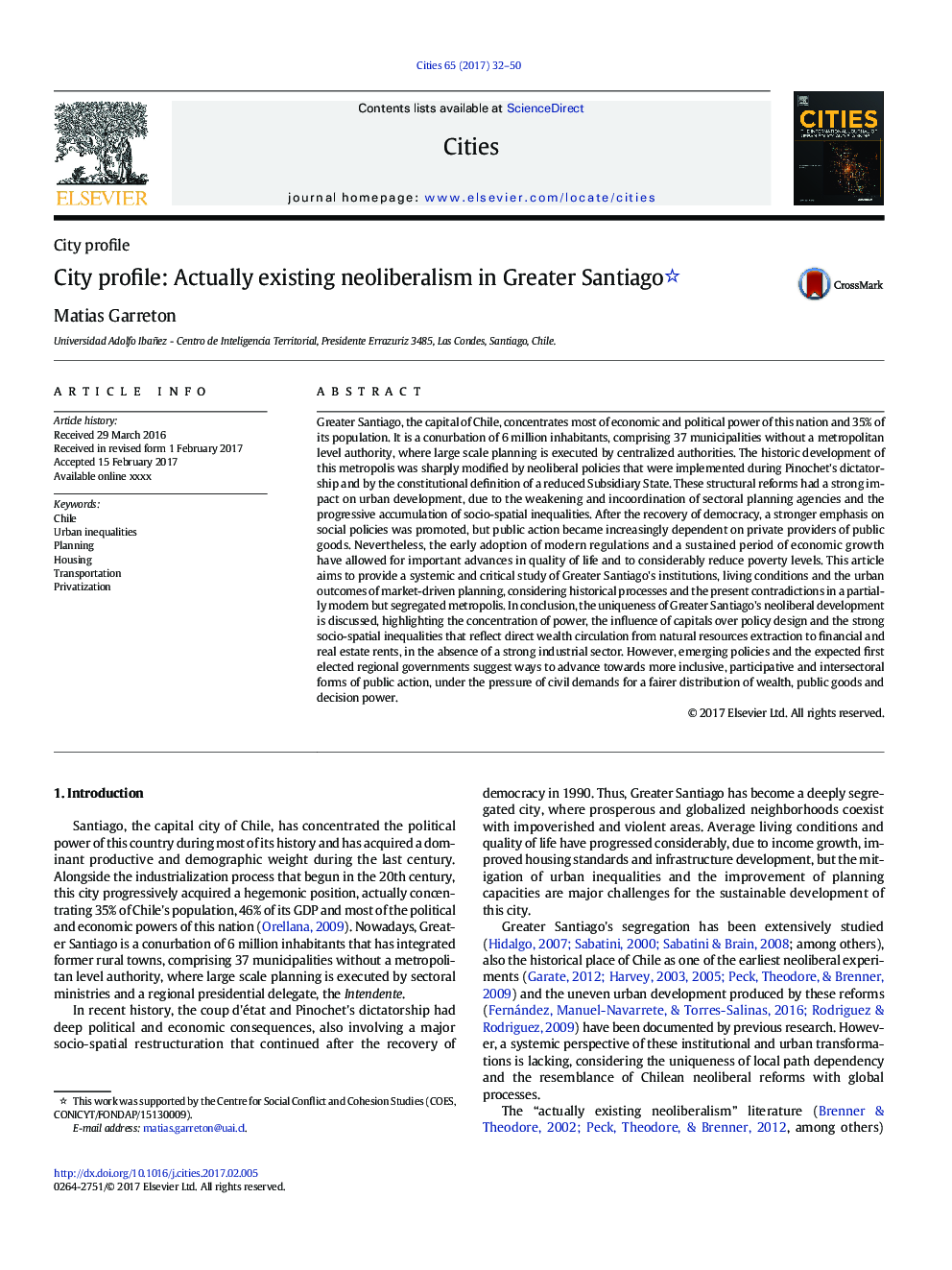| کد مقاله | کد نشریه | سال انتشار | مقاله انگلیسی | نسخه تمام متن |
|---|---|---|---|---|
| 5108091 | 1482331 | 2017 | 19 صفحه PDF | دانلود رایگان |
عنوان انگلیسی مقاله ISI
City profile: Actually existing neoliberalism in Greater Santiago
ترجمه فارسی عنوان
نمایه شهر: در واقع نئولیبرالیسم موجود در سانتیاگو بزرگ
دانلود مقاله + سفارش ترجمه
دانلود مقاله ISI انگلیسی
رایگان برای ایرانیان
کلمات کلیدی
شیلی، نابرابری شهری، برنامه ریزی، مسکن، حمل و نقل، خصوصی سازی،
ترجمه چکیده
سانتیاگو بزرگ، پایتخت شیلی، اکثر قدرت اقتصادی و سیاسی این ملت و 35٪ جمعیت آن را تمرکز می دهد. این شهر دارای جمعیت 6 میلیون نفری است که شامل 37 شهرداری بدون قدرت در سطح کلان شهر است که برنامه ریزی های گسترده ای توسط مقامات متمرکز انجام می شود. توسعه تاریخی این کلانشهر به شدت توسط سیاست های نئولیبرالی که در دوران دیکتاتوری پینوشه اجرا شد و با تعریف قانون اساسی یک دولت جانبی کاهش یافته، اصلاح شد. این اصلاحات ساختاری به دلیل تضعیف و عدم هماهنگی آژانس های برنامه ریزی بخش ها و تجمع متراکم نابرابری های اجتماعی و فضایی، تأثیرات مهمی در توسعه شهری داشته است. پس از بهبود دموکراسی، تأکید بیشتر بر سیاست های اجتماعی ارتقاء یافت، اما اقدام عمومی به طور فزاینده ای وابسته به ارائه دهندگان خصوصی کالاهای عمومی شد. با این وجود، تصویب سریع مقررات مدرن و یک دوره پایدار رشد اقتصادی، پیشرفت های مهمی در کیفیت زندگی و کاهش قابل توجهی از فقر را به وجود آورده است. این مقاله با هدف بررسی سیستماتیک و انتقادی از مؤسسات بزرگ سانتیاگو، شرایط زندگی و نتایج شهری برنامه ریزی مبتنی بر بازار، با توجه به فرایندهای تاریخی و تناقضات کنونی در یک کلان شهر مدرن اما متمایز است. در نتیجه، منحصر به فرد بودن توسعه نئولیبرال بزرگ سانتیاگو مورد بحث قرار می گیرد، برجسته تمرکز قدرت، نفوذ سرمایه در طراحی سیاست و نابرابری های اجتماعی و فضایی قوی است که نشان دهنده گردش مستقیم ثروت از استخراج منابع طبیعی به مالی و اجاره ملک، در فقدان یک بخش صنعتی قوی. با این حال، سیاست های نوظهور و دولت های پیشین منتخب منتخب منطقه ای پیشنهاد می دهند راه هایی برای پیشبرد شکل های فراگیر، مشارکتی و میانجی از اقدامات عمومی تحت فشار تقاضاهای مدنی برای توزیع عادلانه ثروت، کالاهای عمومی و قدرت تصمیم گیری.
موضوعات مرتبط
علوم انسانی و اجتماعی
مدیریت، کسب و کار و حسابداری
گردشگری، اوقات فراغت و مدیریت هتلداری
چکیده انگلیسی
Greater Santiago, the capital of Chile, concentrates most of economic and political power of this nation and 35% of its population. It is a conurbation of 6 million inhabitants, comprising 37 municipalities without a metropolitan level authority, where large scale planning is executed by centralized authorities. The historic development of this metropolis was sharply modified by neoliberal policies that were implemented during Pinochet's dictatorship and by the constitutional definition of a reduced Subsidiary State. These structural reforms had a strong impact on urban development, due to the weakening and incoordination of sectoral planning agencies and the progressive accumulation of socio-spatial inequalities. After the recovery of democracy, a stronger emphasis on social policies was promoted, but public action became increasingly dependent on private providers of public goods. Nevertheless, the early adoption of modern regulations and a sustained period of economic growth have allowed for important advances in quality of life and to considerably reduce poverty levels. This article aims to provide a systemic and critical study of Greater Santiago's institutions, living conditions and the urban outcomes of market-driven planning, considering historical processes and the present contradictions in a partially modern but segregated metropolis. In conclusion, the uniqueness of Greater Santiago's neoliberal development is discussed, highlighting the concentration of power, the influence of capitals over policy design and the strong socio-spatial inequalities that reflect direct wealth circulation from natural resources extraction to financial and real estate rents, in the absence of a strong industrial sector. However, emerging policies and the expected first elected regional governments suggest ways to advance towards more inclusive, participative and intersectoral forms of public action, under the pressure of civil demands for a fairer distribution of wealth, public goods and decision power.
ناشر
Database: Elsevier - ScienceDirect (ساینس دایرکت)
Journal: Cities - Volume 65, May 2017, Pages 32-50
Journal: Cities - Volume 65, May 2017, Pages 32-50
نویسندگان
Matias Garreton,
